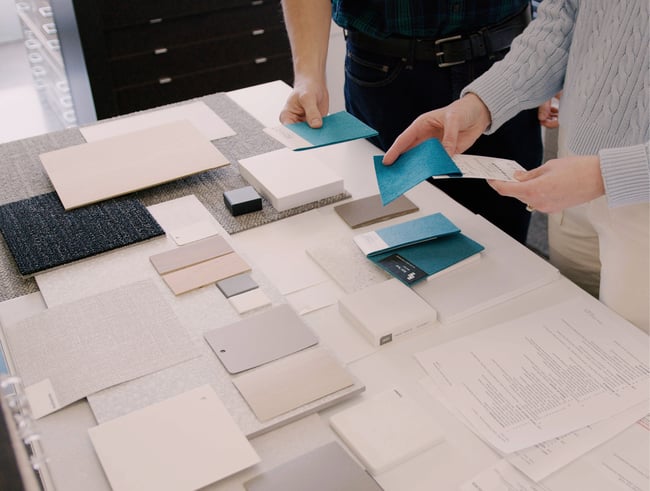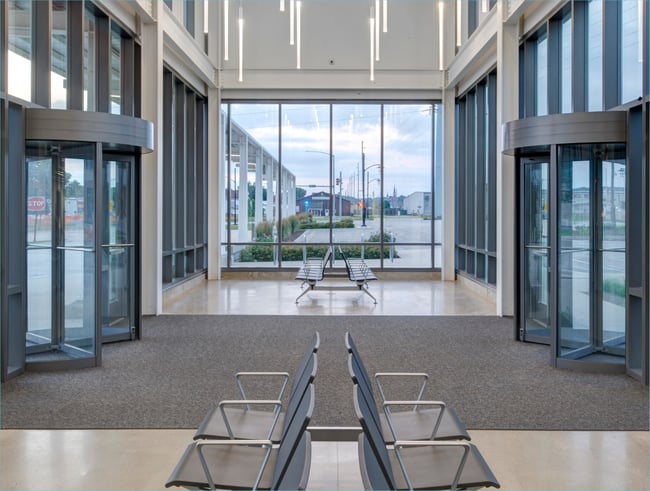Improving Indoor Air Quality with the WELL Standard

With Canadian wildfire smoke sweeping parts of the US, air quality has been a hot topic this summer. Many people worry about the short- and long-term health impacts of air pollution and are taking measures to protect themselves.
While improving outdoor air quality requires a global effort, designers can help make improvements within the built environment. The WELL standard, a third-party building certification system focusing on human health, provides a pathway to healthier indoor air quality.
Recently, we have been researching WELL and helping our clients understand how it can apply to their projects. This article will discuss some of the WELL strategies for improving indoor air quality and protecting occupants.
WELL Strategies for Improving Indoor Air Quality
1. Increased Ventilation and Filtration
Many routine indoor activities—like cooking, cleaning, and occupying a space—can degrade indoor air quality. Spaces need to be properly ventilated to remove particulate matter and other pollutants that harm human health.
WELL sets standards for ventilation. For example, in spaces with an expected occupant density of 25 people or more, WELL requires demand-controlled ventilation systems that keep carbon dioxide levels below 800 ppm. Such systems circulate fresh air based on the amount of carbon dioxide in the atmosphere.
Effective ventilation requires quality outdoor air. To ensure fresh air does not contain particulate matter, WELL specifies the use of carbon and media filters.
HVAC systems and filters should be monitored and tested to maintain a basic level of indoor air quality. For example, maintenance teams should monitor the levels of carbon monoxide, radon, formaldehyde, ozone, and other pollutants.
During the design process, most of this work falls on the mechanical engineer. Your architect and interior designer should work with the engineer to help them understand the requirements and ensure systems meet WELL’s standards.
2. VOC and Toxic Material Reduction
Volatile Organic Compounds (VOCs) are found in many building materials, including paints, coatings, and some textile products. They are also common in cleaning products, air fresheners, personal care products, and other substances occupants can introduce into a building.
In high concentrations, VOCs can lead to nose and throat irritation—a condition known as “sick building syndrome.” They are even linked to cancer, childhood asthma, and respiratory illnesses.
The WELL standard sets requirements for VOC reduction, including the use of VOC-free paints, coatings, interior adhesives, and sealants. Large materials like flooring, insulation, and furniture must also contain low VOC levels.
In recent years, VOC-free products have become more widely available, making it easier to achieve this goal. Your design team can help you select healthier materials within your price point.

Thoughtful material selection can reduce VOCs and other pollutants.
Beyond VOCs, building materials contain many other chemicals that can degrade indoor air quality, including flame retardants, formaldehyde, and phthalates. Designers should take steps to limit the introduction of these materials into interior environments.
Learn more by reading about unhealthy building materials and how to avoid them.
3. Mold and Moisture Control
Moisture condensation within HVAC systems can cause mold growth, affecting indoor air quality. Moisture and mold can also collect in wall assemblies due to water damage or improper detailing in humid locations like kitchens or bathrooms.
Regular contact with mold spores leads to several negative health impacts, including asthma, headaches, allergies, and other respiratory illnesses. To prevent these issues, WELL specifies regular HVAC inspections and cleanings. Ultraviolet lamps can also be used within HVAC systems to reduce moisture.
Additionally, WELL sets standards for building envelope design to reduce moisture in wall assemblies.
4. Healthy Entrances
Building occupants can also degrade indoor air quality. As they enter the building, they may track harmful contaminants like bacteria and pesticides.
To reduce the likelihood of these contaminants entering regularly occupied spaces, WELL suggests permanent entryway systems consisting of grilles, grates, or slots that can be easily cleaned. Rollout mats and gritty walk-off carpets that scrape shoes are also effective.

Walk-off carpet can reduce contaminants from entering the building.
Additionally, owners might consider adding a staging area, also known as a mud room. Occupants can remove coats and change shoes before entering the space, helping maintain a clean interior. In the winter, staging areas can prevent occupants from tracking substances like road salt.
5. Cleaning Protocols
Regular cleaning helps maintain healthy indoor air quality by reducing the concentration of germs and other harmful substances. However, many cleaning products contain chemicals like VOCs that undermine these efforts.
The WELL standard specifies non-toxic, hypoallergenic cleaners that reduce environmental allergens and unpleasant odors. Maintenance teams should establish a regular cleaning schedule and use a list of approved products.
6. Construction Pollution Management
While design and material selection can go a long way, construction also plays a role in maintaining healthy air quality. Dust, chemical vapors, and debris can linger in the air after construction, posing risks in the early days of occupancy.
To reduce construction pollution, WELL sets guidelines for contractors. For example, contractors should seal air ducts during construction and replace HVAC filters before occupancy. Absorptive materials—like carpets, ceiling panels, and upholstery—should be stored in a separate area.
Construction teams can also perform an air flush after construction is complete. This practice forces air through a building and helps remove particulate matter and pollutants.
Learn More about the WELL Building Standard
Improving indoor air quality is a team effort, and design teams need to work with mechanical engineers, maintenance staff, and contractors to ensure everyone follows the best practices. Thoughtful HVAC design, healthy material selections, regular cleaning, and proper construction protocols can lead to healthier interior environments.
Along with air quality, the WELL standard sets requirements for water quality, lighting, thermal comfort, acoustics, and more. Learn how WELL can apply to your project by reading about its ten concepts.